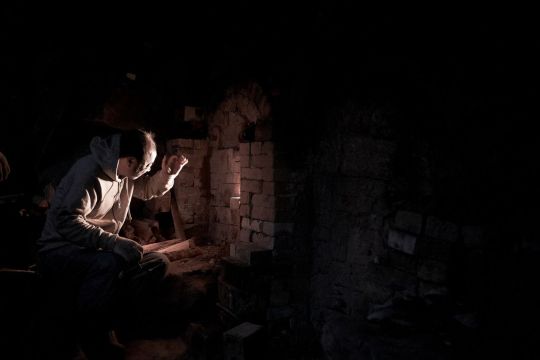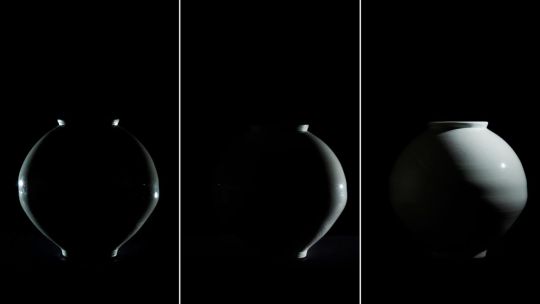#Why These Imperfect Korean ‘Moon Jars’ Sell for Millions
Text

Why These Imperfect Korean ‘Moon Jars’ Sell for Millions
Old, round, imperfect and beautiful — that’s how fans of Korean art describe the moon jar, or “dalhangari.”
These unassuming, plain white pots have entranced everyone from rapper RM, of K-pop sensation BTS, to philosopher Alain de Botton.
The former director of London’s Victoria and Albert Museum, Beth McKillop, has called the moon jar an “icon of Korean identity.” And if price is any indicator of popularity, one recently sold for over $4.5 million at a Christie’s auction.
This month, a rare example from the late 17th or early 18th century will go on sale at Sotheby’s in New York, where it’s expected to fetch more than $3 million.
“A large moon jar has always been expensive, but I think the big uptick in prices and value is… because their appeal is now global,” said Angela McAteer, Sotheby’s international head of Chinese art for the Americas and Europe, over video call. “You’ve got an international cohort of bidders competing for them, so it’s gone beyond the traditional connoisseur collecting community of Korean art.”

Huge price tags also result from the jars’ rarity. Although made for over a century in the royal kilns of Korea’s last kingdom, the Joseon dynasty, few are thought to exist today. Estimates for the number of larger ones (those more than 40 centimeters, or 15.7 inches, tall and wide) that have survived over the years range from 12 to 30.
Having passed through auction houses and antique dealers across the world, several of these are now in the collections of institutions like the British Museum and Boston’s Museum of Fine Arts, as well as in the hands of private collectors.
‘Owning a piece of happiness’
The first moon jars were created in the royal kilns in Gwangju (a city just outside Seoul, not the larger southern city of the same name) from 1650 to 1750. They were made from pure white porcelain and kaolin clay, and, following the neo-Confucian fashions of their day, the pots reflected values such as propriety, humility, frugality and purity. They were likely used at court and in upper-class homes as containers for food and liquids, or as decorative vessels.
In the mid-20th century, moon jars began gaining international appreciation thanks to influential admirers such as Japanese folk crafts scholar Yanagi Soetsu and British potter Bernard Leach, who bought one from a Seoul antique store in 1935. Leach once said that having a moon jar was like “owning a piece of happiness,” and would later give his to fellow potter Lucie Rie for safekeeping during World War II. It stayed in her studio until her death and was later acquired by the British Museum.
Charlotte Horlyck, lecturer in Korean Art History at the University of London’s School of Oriental and African Studies, wrote in the Art Bulletin journal that after World War II the moon jar “caught the attention of an early generation of postcolonial Korean artists and scholars who sought to restore Korean art history and national identity,” as the pieces “resonated with the visual language of international modernism and minimalism of the mid-20th century while remaining a distinctly Korean work of art.”
The moon jar’s allure
When Sotheby’s announced its forthcoming sale, the auction house described its 44-centimeter (17.3-inch) moon jar as an object that inspired, astounded and soothed those who “stand in its presence.” It’s a funny thing to say about a pot, to speak as if it’s alive, but the jars’ visceral, emotional impact on people is something that comes up time and time again in the literature.

Choi Sunu, a former director of the National Museum of Korea, has described the museum’s moon jars as being like companions, or muses that have inspired his writing and stirred his creativity. Bernard Leach admired the pots for their “natural unselfconsciousness.” In 2012, South Korea’s then-Unification Minister Yu Woo-ik used the pot as a metaphor symbolizing a reunified Korean peninsula (moon jars are created in two hemispherical pieces and joined in the middle).
More recently the rapper RM, of K-pop group BTS, posted a picture of himself hugging a modern-day moon jar on Twitter, telling fans that the pots made him feel calm.
“It’s hard for someone to really comprehend how a pot can make you feel that way,” said McAteer. “It has this real meditative presence. If you’ve sat in front of a great (painting by US artist, Mark) Rothko and you feel this kind of palpable energy emanate from it, and you could sit for hours and just feel something in its presence — the moon jar has that too.”
“The more you look at it, the more there is to see. It looks different from every angle,” she added. “We had real issues with the photography and the catalog because it looks like a different piece every time you rotate it, or you change the lighting. The surface is just alive, you know.”
“You can see how the glaze coalesces; you see these spontaneous bursts of this blush color that’s happening in the firing. You can lose yourself in its surface.”
Modern masters
Modern Korean potters have been inspired by the jars, and a number have come up with their own homages. Ceramist Kim Syyong covers his pots with a black glaze, while Yun Ju Cheol’s versions look spikier like a pufferfish and Choi Bo Ram’s unvarnished, textured blue vases have a denim-like quality.
Others, like Kwon Dae Sup, have looked to closely recreate the process used by the potters of yore. The 71-year-old ceramist produces unadorned white jars and allows for all the beautiful imperfections produced to shine through. He works out of a studio in Gwangju, where the royal kilns that produced moon jars were once located.



There’s a great deal of preparation that goes into making a moon jar traditionally. It’s labor-intensive: washing, sifting impurities from the clay, kneading and rolling it to remove air bubbles, carrying around these large hunks, not to mention hand throwing the clay itself to that oversized bowl shape without collapsing, and the work keeping a pine wood fire burning for 24 hours while the pot hardens in the kiln. Kwon also built his own kiln to replicate the old process as closely as possible.
“I do this because it’s fun,” he said in a phone interview. “Every time I make something, it’s novel … The quality of the material is different every time. The conditions in which I make the pots is new every time.”
Kwon said he also feels an emotional connection to the moon jar. As a student he was so moved by a one he saw in a Korean antique store that he decided they would be his life’s work. “They feel alive,” he said.
In a 2019 book on his work by Axel Vervoodt Gallery the potter is quoted saying he tries to produce art that needs no addition or subtraction. “I wish to create work that has an imposing presence but harmonizes with its surroundings regardless of where and when it is displayed. It should give peace of mind and a sense of comfort to all who look at it.”
By Christy Choi.

#Moon Jars#Why These Imperfect Korean ‘Moon Jars’ Sell for Millions#Dalhangari#Joseon dynasty#pottery#porcelain#Bernard Leach#Lucie Rie#Kwon Dae Sup#ancient artifacts#archeology#archeolgst#history#history news#ancient history#ancient culture#ancient civilizations#korean history#korean art#art#artist#art work#art world#art news#long reads
127 notes
·
View notes